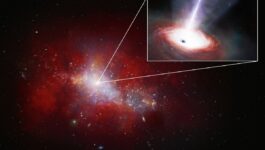
James-Webb detects a record-growing black hole!
Illustration of a so-called red dwarf galaxy which hosts a supermassive black hole in the super accretion phase. © NOIRLab / NSF / AURA / J
It doesn't have a very pretty name (LID-568), but it is bright, which is a shame for a black hole. The astronomers of theInternational Gemini Observatory in the USA have noticed that it crosses a critical threshold in terms of speed ofaccretion of matter. In other words, the speed at which it absorbs the latter in rotation around it. This black hole “eats” too much.
Space telescope identifies too voracious Gargantua
Let's finish the presentations before detailing why and how this discovery is a real step forward in understanding the evolution of the first galaxies. LID-568 is found in the Universe then only 1.5 billion years old — it is 13.78 billion today. It resides in a galaxy called AGN (Activ Galaxy Nucleus) where we see that its core, and therefore its central black hole, absorbs a lot of matter.
This distant galaxy is an AGN. The quasar at its center shines like hundreds of billions of stars. © NASA / ESA / John Bahcall (Institute for Advanced Study, Princeton) Mike Disney (University of Wales)
Originally, LID-568 appeared in a catalog of galaxies from the Chandra telescope, specialized in X-rays. However, it is precisely this type of radiation that characterizes AGN and the gluttony of black holes. Indeed, when matter falls while spinning around a black hole in its accretion disk, it heats up and radiates more and more strongly as it gets closer to the event horizon.
Now let's make the analogy of a giant who gags so much that a certain amount of food cannot enter through his mouth. This is a bit like what happens with black holes, with this difference: the matter arrives so quickly on the spherical horizon (roughly spherical in reality) that it will go up along magnetic lines and being expelled in the form of a jet. This is how black hole flow jets are formed.
A jet from the supermassive black hole M87*. The latter extends over at least 5000 light years away. © NASA/ESA/Hubble ST
This supermassive black hole explodes the Eddington limit by 44%
There is a limit, called the Eddington limit, which corresponds to the maximum possible luminosity for a spherical object accreting matter. Beyond this limit, the radiation pressure is supposed to overcome gravity. We then think that this very complex mechanism is linked to the appearance of the strong flows of matter observed, for example with jets from black holes. LID-568 is precisely 44% beyond the Eddington limit.
Without the James-Webb, this “super Eddington” black hole would undoubtedly have gone under the radar, because its mass is not extraordinary. It “weighs” 7 million solar masses, which is impressive for a black hole from the early Universe, but insufficient to stand out among other AGN galaxies.
“Ultimately, detection of LID-568 would be impossible without JWST. The use of the integral field spectrograph was innovative and necessary to obtain our observation”enthuses Emanuele Farina, international astronomer at the Gemini Observatory/NSF NOIRLab and co-author of the article.
Position of LID-568 on a plot of luminosity versus black hole mass (over the galaxy's stellar mass). We see that LID-568 stands out notably. © Hyewon Sue et al, Nature Astronomy, 2024
The “super Eddington” phase is a good clue to explain the rapid growth of supermassive black holes
There are still many mysteries surrounding the formation and growth of supermassive black holes. In particular, we don't know how some can be so big so early. This “super Eddington” phase therefore seems to constitute a good clue as to their rapid evolution.
The authors of the study also recall that there are two main hypotheses for their formation: either these black holes are born from “heavy” seeds, that is to say from giant gas clouds which collapse directly into black holes , or “light” seeds, primitive stars much more massive than those we know today.





